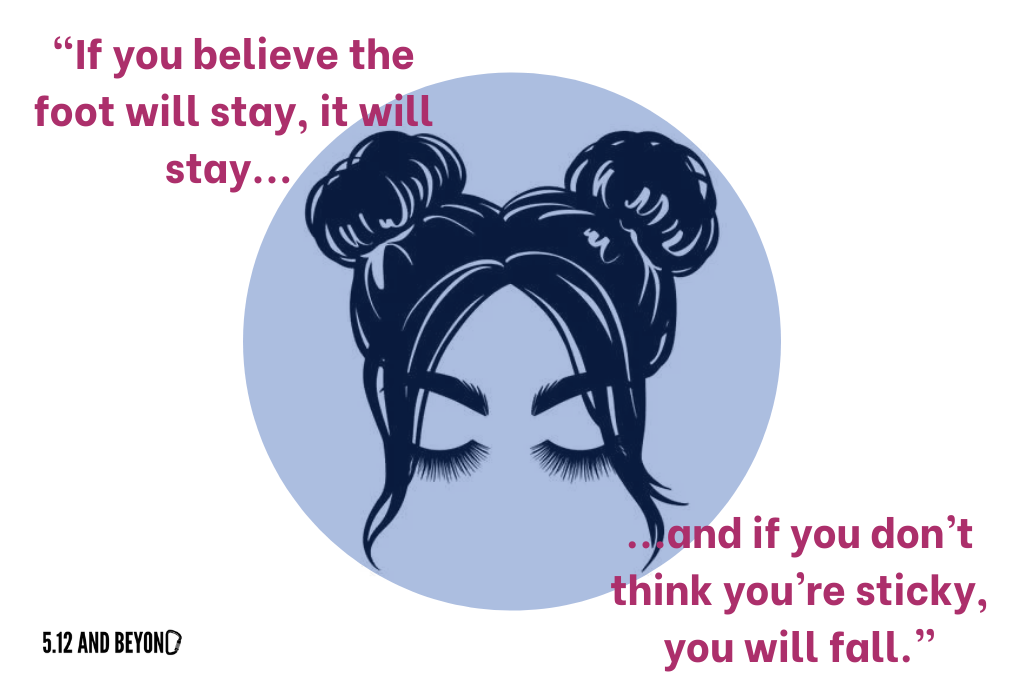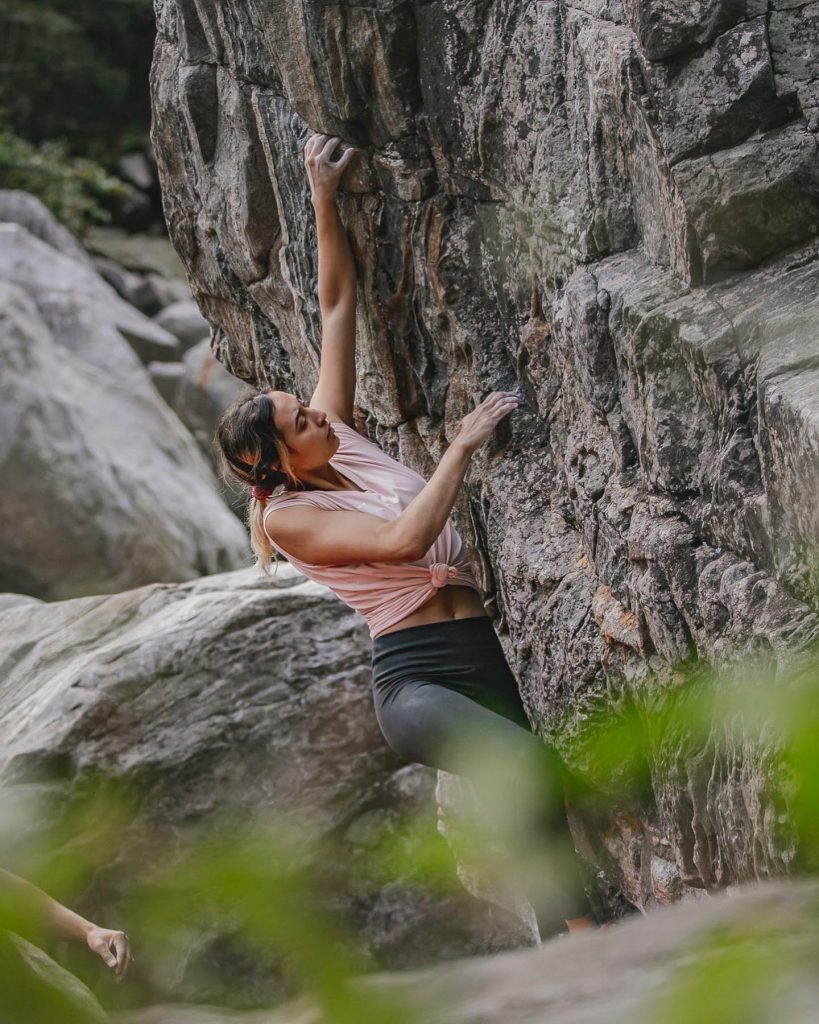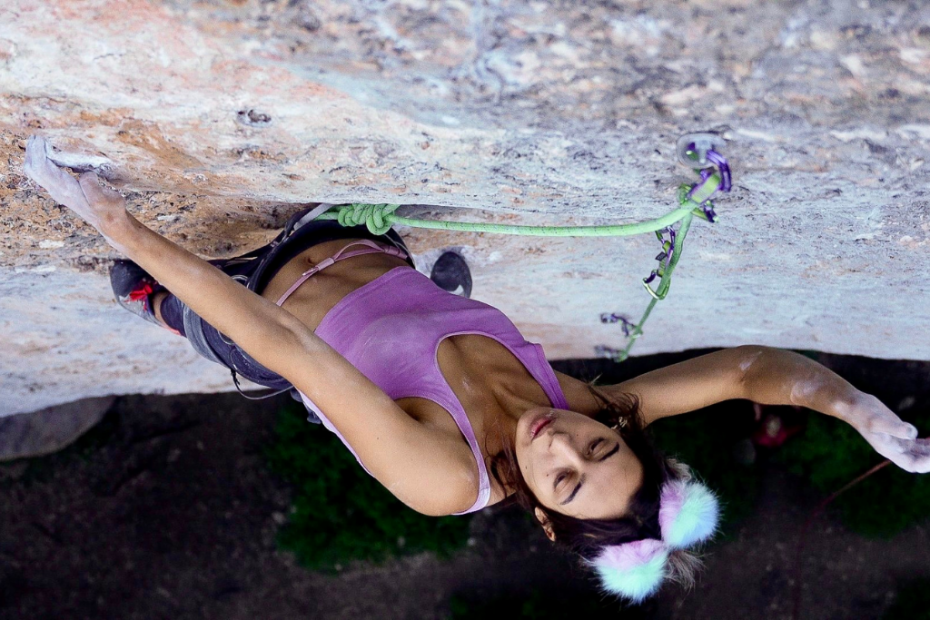Welcome to the third and final installment of my interview with Anna Hazelnutt. If you missed the first and second parts, here are two respective links:
Anna and I have talked about fear, and we’ve talked about failure. In climbing, these are two of the biggest things that can hold you back. So if you can work with fear and failure, you’re in good shape. Now, it’s time to talk about climbing.
Part Three: Climbing
Anna is a slab crusher. She’s sent 5.14a slab routes and V9 slab boulders. I can personally attest to her prowess here, having seen her destroy some slabs at the gym. So, obviously, I asked her how she does it. Turns out, Anna has a theory on slab: why people don’t like it, and why she does.
“Slab has such a high failure rate: if you breathe wrong, you fall.”
According to Anna, you have to try a slab so many more times than anything else just to understand if you can do it or not. In other styles, you can pull on and get an idea of what you might need to do – say, lock off a crimp, or do a big huck – and then try the move until you do it or decide it’s too hard. You have the ability to gauge where you’re at.
But with slab, you’re standing on nothing and holding nothing, and the beta is far from clear. “You get on it, and then you fall”, Anna says, “and then you’re like ‘well maybe, if I move my foot a millimeter to the left…’ And then you try it again. It just takes so much more patience and ability to fall fall fall fall fall”.
Anna and I likened slab to an unconventional job – say, music – compared to vert or steep: medicine and law. All three paths require blood, sweat, and tears. But with music, there’s no defined path to success. You can be putting in all the work without knowing if you’re even going in the right direction.
If you want to climb crimpy vert, get stronger fingers. If you want to climb burly steeps, work core and upper body. But if you want to climb slab, the path is much less clear – both figuratively and literally… it doesn’t have holds. “Slab is a blank canvas, versus something very physical that you can target.”
So, how do you climb slab?
Anna says that slab is all about mental fortitude. “The difference between sending and not sending a slab could just be the level of confidence you have.”

As I’m sure you know, slab doesn’t have the best reputation. It’s far from universally enjoyed. But, according to Anna, people just don’t respect it enough: they don’t spend the time to understand the effect of their thoughts.
“Slab reads your emotions like a map. Any kind of stress you’re holding will impact how you can balance. ”
I asked Anna how she gets into the right mental state to slab. “It’s like a form of meditation, where I’ll try to eradicate any thoughts from the day, from life, or whatever’s happening in my mind.” Anna uses breath – a lot – to focus and calm down, as well as self-affirmation. “I really positively talk to myself on the wall.”
This is a practiced thing. Anna takes a big, deep breath before she pulls on, and then she’s in the zone. “It’s game time. My whole mood changes.” And that’s why she gravitates toward slab: Anna is more practiced and more proficient at slab, so getting into that hyper-focused, zen mode is easier for her there.

Mental work is typically much less measurable than physical work: it’s skill versus strength. And it can be unappealing to target. In this day and age, where fitness is gamified, we all want to “tick” a gym session. We want to hang more weight on smaller edges, and we want to be able to pull more. But the path to improving your mental fortitude is, again, much less clear. One key ingredient to slab success, according to Anna, is tenacity.
“If you’re committed to figuring out a slab, that’s the best thing you can do for yourself.”
Anna and I agreed that when you’re trying something that’s hard for you – slab or otherwise – it doesn’t mean much if it feels impossible at first. Even if it seems like there’s no way you’ll ever do it, that can change within a single session. “It’s happened so many times before where the impossible becomes possible,” Anna says. So you should try things that feel hard – really hard.
I’ve actually written about this before – it was super important in my personal progression. And, as Anna points out, what’s the worst thing that can happen? You’ll fall… just like all the other times. Hard things don’t bite! If you can’t do something in a style you’re not proficient at, sure, you might not be strong enough. Or, you might just not understand the movement yet. You won’t know unless you try.
“It’s not that I can’t do it – it’s just that I don’t know how yet.”
Now, a conversation about climbing – especially one that includes bold trad routes (see parts one and two of this interview) – is not complete without talk of risk and injury.
Assessing risk
Anna’s risk assessment is two-fold. First, she looks at the reality of the situation, checking out the falls and noting any no-fall zones. Then, she takes into account her level of confidence in her ability to do the thing. For Once Upon A Time In The Southwest, Anna considered the risk to be high – but her confidence was also high, leading to her decision to climb the route. Anna notes that it’s important to listen to the gut too: there are no hard-and-fast rules that will tell you whether it’s a good idea to climb something or not.

Dealing with injury
Anna’s stance on injury is that “it’s a part of the risk we take”. Injuries happen to everybody. Sure, you can do things to mitigate your chances of getting injured. But if you climb rocks, injury will always be a factor. It’s not the end of the world, though. While Anna and I have both experienced being injured and utterly miserable, it doesn’t have to be that way.
The reality is that if you like climbing, and you’re passionate about it, it’s not that difficult to come back. Most injuries are a short-term thing, and some you can climb around. Anna actually sent Once Upon A Time with a sprained toe. If you accept that injury is a part of climbing, it’s that much easier to deal with when it does happen.
“Sometimes you’re just going to have a broken foot and you’re going to have to work around it.”
That said, Anna makes sure to supplement her climbing with strength training and physical therapy work – as well as taking the time to do a thorough warmup every session. It’s “prehab”, Anna says, noting that she largely manages to stay uninjured these days after sustaining a lot of injuries earlier on.
In my experience, figuring out how to avoid injury is part of the learning curve of climbing: just as you learn technique, you have to learn how to interpret what your body is telling you – as well as how to correctly assess falls. And the only way to do that is through experience. That’s why you’ll find most climbers get injured a lot in their first few years before the incidence tapers off dramatically. You just get better at it.
And that concludes my interview with Anna. Thanks for reading! It was an absolute delight, and I hope you got something valuable out of it – I certainly did. Keep an eye out for the next installment of The 5.13 Chronicles: I’m aiming to feature one climber a month.
And make sure to follow me on Instagram or drop your email below so you don’t miss out.
Featured image credit: Jenny Walters
